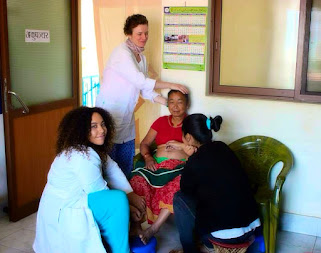| Photo by Jason Leung on Unsplash |
This past week, as part of our Media Relations course within
the PR program, we focused on the topic of communications and media practices during
times of crisis. My memory was triggered during this class module because it brought
to the forefront of my mind the experience I had in Kathmandu Valley during
the 2015 Nepal earthquake.
The
number one takeaway of how communications are managed during times of crisis
is the importance of “public safety” and how to effectively translate messages
to the masses in a way that establishes directedness, responsibility, and trust
to the audience. Effective communication principles used during a crisis often
include establishing response within the first 24 hours and the first week
after a disaster happens.
In 2015, I had the opportunity to
go to Nepal to complete a three-week acupuncture internship through a
partnership between my school, The Institute of Traditional Medicine, and the
Vajra Varahi Healthcare Clinic in Chapagaon, Kathmandu Valley. The clinic shares
land with the Pal Do-Ngak Nyida Mindrol Norbuling Monastery, where Buddhist
monks as young as four years of age receive housing and education. During the
first couple of days, our team, which included two of my best friends, Ashley
Short, and Tijen Yalchin – received education on earthquake protocols and
what to do if the situation occurred. Myself at the Vajra Varahi Healthcare Clinic
However, throughout our information sessions
our hosts encouraged us to not be worried, as the country had not had a major
earthquake in 80 years. However, on the sixth day after we arrived in Nepal, a 7.8
magnitude earthquake occurred that destroyed much of Kathmandu city, surrounding
towns and villages throughout Kathmandu Valley, and caused extreme mudslides
across the mountainous regions. Over nine thousand people lost their lives from
this catastrophic event. Within the first hour of the tragedy, news releases
were sent out around the world to media platforms, which resulted in my family receiving
the story of what happened in Nepal hours before I even had a chance to let
them know I was safe.
Due to
the ability of distributing mass messages through communication tactics,
countries around the world were able to effectively administer aid in different
forms. According to a report from the Government of Canada, within five days of
the earthquake, Canada allocated ten million dollars for humanitarian assistance
to Nepal to help victims and displaced families, and launched the Nepal Earthquake
Relief Fund to engage Canadian citizens to donate. Effective communication
practices allow countries, organizations, or institutions the ability to “demonstrate
leadership in resolving situations,” and are the key to ensuring that the most vital
information and messages are received and understood. Click here to review Canada's Response to the 2015 Nepal earthquake .
During times of crisis, it is
especially effective for communication specialists to appeal to the emotional
status of the situation at hand, and the audience receiving the message. We
have learned how necessary it is for communicators to express regret and
empathy, to take responsibility for the outcome, to directly address the issue
at hand, formulate action steps towards a resolution, and offer restitution if viable.
A few of the ways in which the crisis in Nepal was managed by leadership and
organizations during that time were communicating quickly and frequently with local
and global media outlets, issuing media responses with facts, information centers were offered through the consulates across Nepal, and news conferences were
used to allow spokespersons to address issues and updates.
Communication
between media platforms, journalists, and PR specialists should be honest,
direct, and factual. If there is information unknown or not confirmed, it is up
to the communicator to make sure the messages disseminated are helpful and not
obscure to the audience. As we learned in this module, “perception is reality.”
My experience in Nepal was life-changing, and now years later I can look at my
experience with a different lens of how the situation was overseen from a
public relations and humanitarian perspective, versus being on the receiver end
of the crisis. In our module we discussed how sometimes media is not always
fair, and that “bad news sells papers and attracts audiences.” I can say I found
relevancy in this when I reviewed the articles about myself and friends who
experienced the earthquake and the aftermath of that – and how the descriptions
of what happened to us or what we experienced were sometimes embellished or
inaccurate.
 |
| Photo by Markus Winkler on Unsplash |
Communications during times of crisis is a major factor to influencing whether outcomes are positive or negative, and how effective messaging to media and audiences can pull individuals across the globe together to encourage necessary change or aid. As someone studying in Mohawk’s Public Relations Grad program, I am grateful for the opportunity to build on my writing and media relation skills so that in the future I will be prepared to meet whatever communication challenges come my way.
News article: https://www.thespec.com/news/hamilton-region/2015/04/28/hamiltonians-wait-in-tents-in-earthquake-ravaged-nepal.html

Comments
Post a Comment